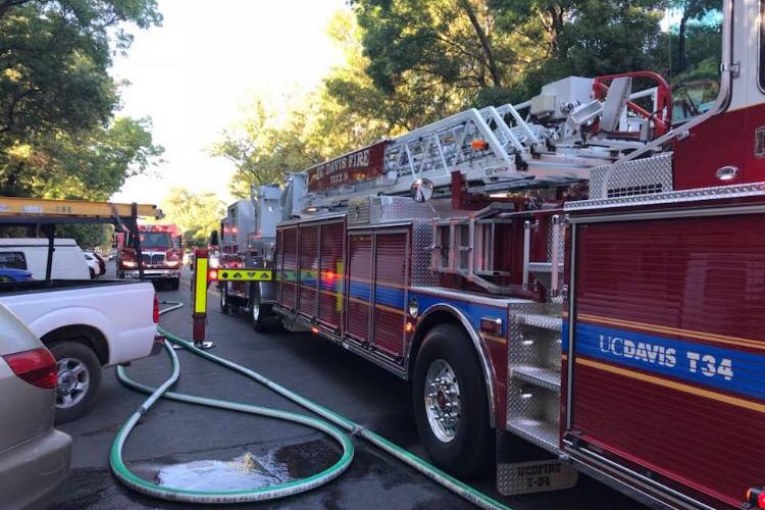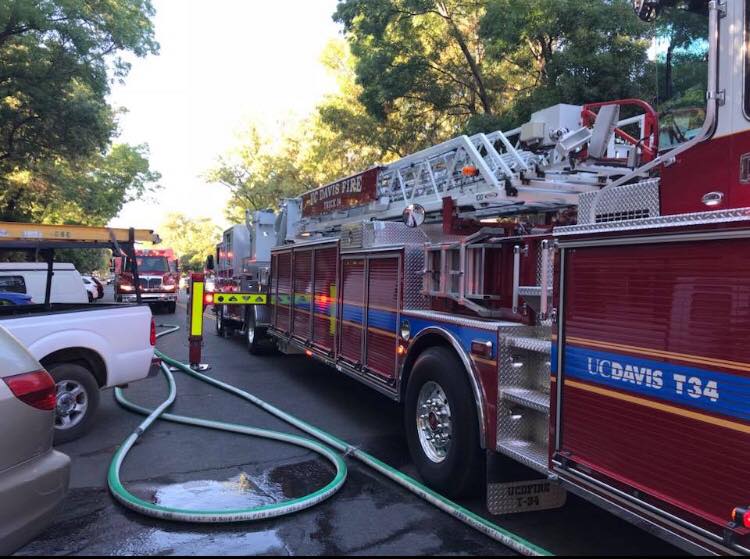

By David M. Greenwald
Executive Editor
Davis, CA – It has been more than a decade since we first laid out the case that the city of Davis, mainly through their own policies, put the city at grave fiscal risk—they raised salaries too much and too fast in a series of MOUs from 2005 to 2009, and they enhanced pension benefits in the early 2000s without considering how to backfill the unfunded liabilities they created.
When the great recession hit, those fiscal decisions were exposed. And for a brief period of time, the city council actually attempted to rein in spending and shore up unfunded pension and retiree medical liabilities.
One thing that has become clear over the last decade as we analyzed it, is that Davis, which still has a funding shortfall, brings in far less in the way of sales tax than most comparable cities its size. That’s a big reason why a decade ago Davis made plans to develop an innovation center which could generate new revenue in property and sales tax to help bridge that gap.
One point I have made an innumerable number of times over the last decade is that it’s not enough to simply add revenue—because if you add spending either through employee compensation increases or new programs and staffing, you wipe out the gains you make from economic development or new taxes very quickly.
It doesn’t seem like council is mindful of that lesson and the need for cost containment, and the council’s lack of  commitment to it definitely frustrated some past councilmembers, including former Mayor Robb Davis.
commitment to it definitely frustrated some past councilmembers, including former Mayor Robb Davis.
Case in point is the ladder truck discussion. Staff and council actually believed that the better strategy for staffing the new ladder truck would be adding six new firefighters and about $1.3 million in annual spending.
However, staff recognized that that was probably not the fiscally prudent course.
Councilmember Will Arnold went so far as to oppose Option 3, arguing that we needed to add additional staffing and that he was not comfortable.
“I’m really concerned about going with this Option 3,” said Councilmember Will Arnold. “I think it sort of on paper looks like it’s saving money, but it has a lot of these potential negative effects.”
Dan Carson felt this motion was “fiscally responsible and it strikes a balance.”
He noted, “Part of the reason we are out to rezone downtown is so that it becomes the economic powerhouse for this community that we want as well as a place for infill housing that will be environmentally sustainable.”
The finances here are problematic. $700,000 in ongoing additional costs. Council believes that they can use grants to cover the first three years, but after year 3 the costs will shift to general fund. They have a plan to pay for it? Not really. It’s more like hoping something will come up.
I call that … pound and pray.
There are times that you really need to make additional expenditures and then find a way to fund them. But is this one of those times?
In the Fitch & Associates Standards of Cover report, they found “it is recommended that the City of Davis invest in their own ladder truck.”
The report added, “A community the size of the city of Davis with the complexity of risk should not be without consistent ladder truck service or depend on an apparatus from distant communities when the UC Davis apparatus is unavailable.”
But how many communities the size of Davis have a 40,000-person campus next door with a fire department with their own ladder truck?
The city of Davis needed the truck approximately 115 times in 2020, though it’s not clear how many times for an actual fire—and it’s not clear how times the city needed a ladder truck, but it was unavailable.
Other numbers have suggested the number of times that the ladder truck has been dispatched and remained on site is more like once a month.
From the start, this seemed like a solution in search of a problem—that the consultant report failed to take into account the actual realities in Davis and the council prioritized a nice-to-have over a need-to-have.
Councilmember Carson’s reference to an economic powerhouse in the downtown is more wishful thinking. I am a strong proponent of the downtown better utilizing space by going above the one- and two-story core. I am also a believer that more mixed use is a way to further revitalize the downtown.
But we have to be cognizant of the economic analysis which suggests that mass densification in the downtown is likely not financially feasible, given high land and construction costs in the city.
Without redevelopment money, we may see the occasional deep pocketed company be able to redevelop, like we saw with University Mall, but for the most part I think it’s going to be few and far between.
The best avenue for economic development is still the potential DiSC project, but it faces an uncertain future with a vote potentially in June. Moreover, while that project might generate $3 to $4 million in revenue, between increasing employee compensation, pensions and retiree medical and now new programs, most of that money has already been eaten up before the project has even been approved.


“The city of Davis needed the truck approximately 115 times in 2020, though it’s not clear how many times for an actual fire—and it’s not clear how times the city needed a ladder truck, but it was unavailable.”
That is utter nonsense. All emergency responses are carefully and precisely recorded and detailed, it’s the single most important statistic for first-responders. The process has been computerized and refined (CAD) for decades.
There is a reason this information is “unavailable.” Someone or more does not want to reveal it.
This legitimate and relevant inquiry concerns an event that happens once every three days, a researcher could sit down and do a hand count in less than an hour. You could get a volunteer to do it.
We have years and years of data on our local fire departments’ calls for service. The vast majority are medical emergencies. Building Code requirements (sprinklers, smoke detectors), fire-resistant construction materials, no smoking allowed in any public building. have made structural fires almost obsolete–be it one story, and all the way to the top of a ladder truck.
Demand that what is “unavailable” become available.
I’m sensing a FOIA request!
And volunteers & statistics . . . right in the Vanguard wheelhouse.
If this doesn’t happen I’m going to be super disappointed.
I’m mean, it’s too late. The ladder ship has sailed, etc.
But what is Alan Miller’s #1, last-word, go-to phrase?
That’s right:
“I told you so”
That was while Joe Krovoza was mayor and Steve Pinkerton was City Manager. Of course they were both vilified by the local unions and even some of the then City Councilmembers piled on. For instance, the day that Pinkerton left his job as City Manager, the local fire dept union held a “going away party” (to which Pinkerton was not invited, of course) at the downtown De Veres bar and Lucas Frerichs, shamelessly demonstrating his fealty, showed up back-slapping and high-fiving with all the union leaders.
And now we see how the mantras of “fiscal responsibility” and “cost-containment” that our current Council is so fond of rolling out when it suits their purposes lie crumbling in the dust.
That “gone party” was some of the Vanguard’s best reporting. I miss those days, the Vanguard was much different back then than it is today. Today the Vanguard seems more business minded and less about sticking it to da man as it was in its earlier years. I guess that’s all part of growth.
You can say that again. Though I’d say ‘pro-developer’ rather than ‘business minded’.
I also remember when the far-left-leaning people in this town were anti-developer and against racism. Now they are anti-racists and pro-developers.
No. It’s not.
“You can say that again. I also remember when the far-left-leaning people in this town were anti-developers and against racism. Now they are anti-racists and pro-developers.”
There’s a split on the left in Davis between the anti-developer group and the group that believe marginalized people need housing.
That’s pretty much national, reflected strongly in the local. Not disagreeing with your assessment.
Has anyone checked the dimensions of the proposed truck, and clearances need to pass through the Richards overhead? [given the vertical curve on the roadway]
Could affect response times…
Oh, now it all makes sense! It’s a giant conspiracy to finally widen the Richards Tunnel 😐
Yes… tied to the c-theory that Betty White, Sindey Potier, Bob Saget were all killed by Covid vaccines…
And, the volcano in the Aleutians, causing tsunami warnings on the coast were all the work of those pro (or con) to another Sarah Palin attempt to run for President…
Definitely, a “bridge”… conspiracies are REAL, and those who don’t believe are ‘deniers’…
Wait, what? I thought that was Alan Pryor.
We’ll make a fiscal conservative out of you yet, Greenwald.
Once the massive, massive Covid-19 giveaway money (and associated inflation) give out over the next few years, the next effect is going to be a country-wide crash of local governments that overspent on ongoing costs that are not sustainable within their budgets.
I’d call that a plan 😐
I have no idea what that means, but I’m gonna use it nonetheless.
Agree. Ending at – not creeping over – the tracks, of course 🙂
Also much agree.
All too true . . . and don’t forget Prop. 13’s commercial-side and its massive part in that. Davis built too much parking-lot & bland one-story downtown, and the economics to allow Davis downtown to get beyond that are dismally challenging.
Well there’s your campaign slogan: “Yes on DISC II: Help Davis Pay for that Ladder Truck we Already Bought!”
I have a question to which I’m sure there is a very simple explanation that I hope someone can provide.
Staff has stated the new ladder truck will require minimally a 3-person crew/shift to operate it. So there will be a total of 6 fire fighter personnel in the downtown fire station at any one time – 3 for the existing truck and 3 for the new ladder truck.
But they have estimated annual staffing needs for the new ladder truck will require only hiring 3 new full-time fire dept personnel to operate the new ladder vehicle. They further estimated this cost at $700,000+ annually . So $700,000 / 3 firefighters= $233,000 which is the approximate average salary plus benefits for current fire dept re-fighting personnel. OK – I get that.
But the fire truck actually has to be ready for immediate deployment and service 365/24/7 over the course of the entire year. But a single 3-person crew can only work, at most, 33% of that total annual time for which ladder truck operational readiness must be provided. Would not the fire dept actually need to hire, at minimum, three 3-person teams to provide that level of around the clock staffing – or 9 new firefighters in total?
If so, then the actual annual staffing costs would seem to be 9 x $233,000 = $2,097,000?
What obvious thing am I missing here?
I’m sure someone official will be getting back you any moment now with the answer . . .
#crickets# #crickets# #crickets# #crickets# #crickets#
Any moment now . . .
#crickets# #crickets# #crickets# #crickets# #crickets#
It looks like they are swapping the current apparatus for the ladder truck: “Under any of the three options presented, six existing firefighters (two per shift) would discontinue daily staffing of the current “squad” apparatus and begin full-time staffing of the ladder truck.”